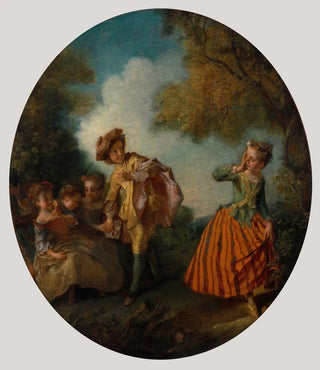Art print | The Blind Man's Bluff - Nicolas Lancret


View from behind

Frame (optional)
In the rich and vibrant universe of 18th-century French art, Nicolas Lancret's "Le bluff de l'aveugle" stands out for its boldness and depth. This art print, capturing a moment of life and emotion, invites us to delve into a world where deception and naivety coexist. The artist, a master of the scene, succeeds in capturing human essence through lively characters, each carrying a story. The scene depicts a blind man, victim of a deception, surrounded by figures oscillating between mockery and compassion. This work is not only a reflection of the society of the time but also an invitation to reflect on human nature and its flaws.
Style and uniqueness of the art print
Nicolas Lancret's style is characterized by a delicacy and lightness that seem almost airy. In "Le bluff de l'aveugle," pastel colors and play of light create an intimate and warm atmosphere. The composition is skillfully orchestrated, each character arranged to attract the viewer's eye while telling a story. Facial expressions, meticulously crafted, reveal a variety of emotions, ranging from mischief to sadness. This ability to convey deep feelings through subtle gestures is one of Lancret's trademarks. Moreover, the canvas is imbued with a sense of movement that brings the scene to life, making each gaze and gesture almost tangible. It is this singularity that allows the art print to transcend time and touch today's viewer.
The artist and his influence
Nicolas Lancret, born in Paris in 1690, is often associated with the rococo movement, an artistic style celebrating lightness, elegance, and sensuality. Raised in an artistic environment, he managed to establish himself as one of the most influential painters of his era. His works, often imbued with a certain irony, explore themes of daily life, customs, and human relationships. Lancret was a pioneer in the representation of genre scenes, influencing

Matte finish

View from behind

Frame (optional)
In the rich and vibrant universe of 18th-century French art, Nicolas Lancret's "Le bluff de l'aveugle" stands out for its boldness and depth. This art print, capturing a moment of life and emotion, invites us to delve into a world where deception and naivety coexist. The artist, a master of the scene, succeeds in capturing human essence through lively characters, each carrying a story. The scene depicts a blind man, victim of a deception, surrounded by figures oscillating between mockery and compassion. This work is not only a reflection of the society of the time but also an invitation to reflect on human nature and its flaws.
Style and uniqueness of the art print
Nicolas Lancret's style is characterized by a delicacy and lightness that seem almost airy. In "Le bluff de l'aveugle," pastel colors and play of light create an intimate and warm atmosphere. The composition is skillfully orchestrated, each character arranged to attract the viewer's eye while telling a story. Facial expressions, meticulously crafted, reveal a variety of emotions, ranging from mischief to sadness. This ability to convey deep feelings through subtle gestures is one of Lancret's trademarks. Moreover, the canvas is imbued with a sense of movement that brings the scene to life, making each gaze and gesture almost tangible. It is this singularity that allows the art print to transcend time and touch today's viewer.
The artist and his influence
Nicolas Lancret, born in Paris in 1690, is often associated with the rococo movement, an artistic style celebrating lightness, elegance, and sensuality. Raised in an artistic environment, he managed to establish himself as one of the most influential painters of his era. His works, often imbued with a certain irony, explore themes of daily life, customs, and human relationships. Lancret was a pioneer in the representation of genre scenes, influencing






